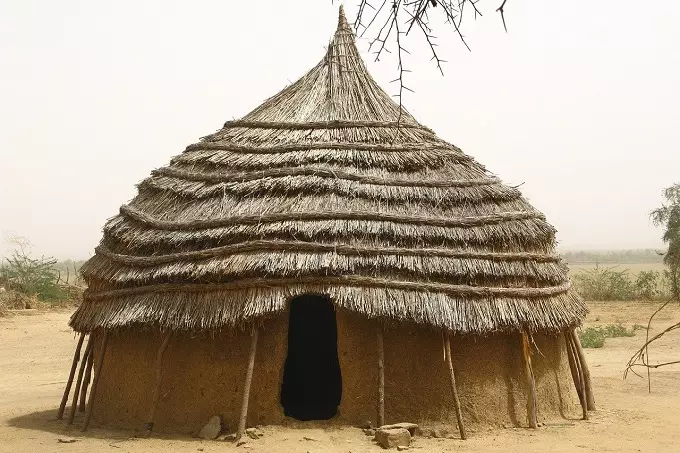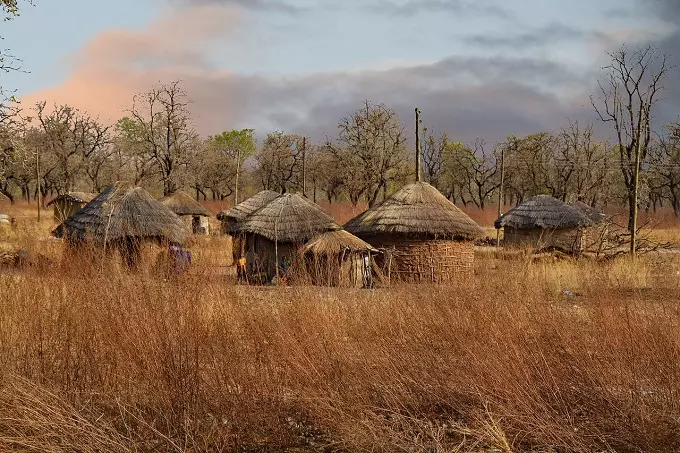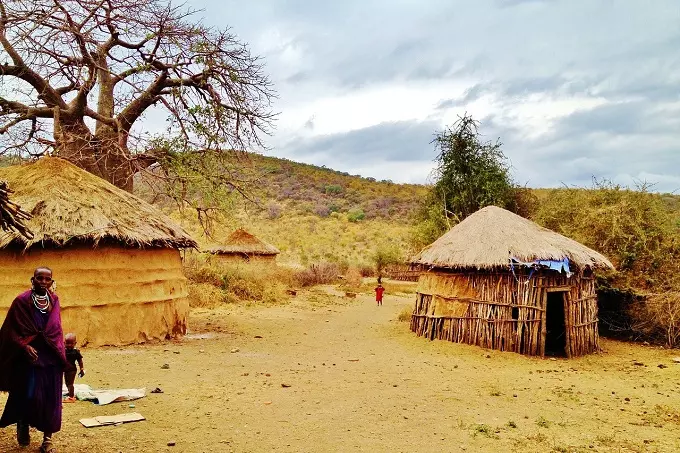The mud huts in Africa and why the Africans live in them

When an image of a hut is seen, one’s thoughts quickly go to the continent of Africa. Huts have been the most common kind of home in the whole of Africa for hundreds of years, and they are often considered to be the most recognizable architectural characteristic of the continent.
Huts are another possible meaning of the phrase place to live. Huts are usually circular in plan, and the tops of these structures often culminate in a point. The majority of the time, they are built out of mud or clay, have a wooden framework for support, and have a thatched roof that is supported by a single wooden pole that is positioned in the center of the building.
There are a lot of individuals who don’t like Africa and think that the continent can’t lay claim to any remarkable civilizations south of Egypt. This is a common misconception. When they say this, they often give the impression that there are no magnificent architectural remnants to be discovered south of the Pyramids in Egypt. In point of fact, architecture or architectural artifacts are sometimes seen as being the distinguishing features of so-called “great civilizations.
Even though the bulk of Africa does not have any such fossil evidence, there are grounds to believe that the architectural choices that Africans have made up to this point have not been created by mistake and are not as simple as they may at first seem to be.
To begin, a large portion of Africa has weather that ranges from warm to hot for the whole of the year and does not have a substantial winter season. Because of the weather, the longest rains, which refer to a stretch of time during which it rains quite a little and virtually every day, are the most unpleasant time of the year. Showers, rather than rain, are the more prevalent occurrence in the majority of Africa.
In contrast to the rain that falls in Europe, for example, which may be moderate but constant precipitation, this refers to a brief period of intense precipitation that arrives all of a sudden and lasts just a short while. Additionally, due to the fact that a large portion of Africa is situated on the equator, the length of daylight and nighttime in Africa is practically similar to one another, totaling precisely twelve hours. In regions such as Europe, where winter nights may run up to eighteen hours long owing to the duration of the night, this is in stark contrast to the situation.
As a direct result of this, the vast bulk of daily activities in Africa takes place in the open air. Only during the night is it necessary to have a shelter in order to protect oneself from the harsh weather and any dangerous animals that may be in the area. There has never been a moment when it was required to spend as much money on housing as, for example, has been done in Europe. Those kinds of expenditures are no longer necessary. To be more specific, there were extremely few occasions in Africa in which the lack of a secure place to sleep constituted a serious danger to one’s life. This is the case even though there are a lot of countries in Africa. It was standard practice in many African communities for nomads, hunters, warriors, and messengers to spend lengthy periods of time away from home without any provision for shelter. This included not only the absence of a house but also the absence of food and water.
The plentiful mud or river clay is plastered over a framework of branches to create huts, and these huts are often not very large in size. Huts are made using this method. They did not cost very much money to produce, either in terms of the work put in or the materials that were used. Plastering the walls and thatching the roof are traditionally considered to be the domains of males and females, respectively, throughout the majority of the world’s civilizations. Manyattas are the names given to the mud dwellings that the Maasai people of East Africa live in. The Maasai woman is the one who is in charge of putting together the whole structure.
The Africans, in contrast to what often happened in the modern world, did not become slaves as a consequence of the acquisition of shelter as a result of their relaxed attitude to the idea of shelter. This was due to the Africans’ laid-back approach to the notion of shelter. Buying a home in today’s highly interconnected and globalized world is a commitment that lasts a lifetime and forces buyers to spend their whole lives chained to a mortgage and always under the shadow of the sword of Damocles, which is the prospect of losing their residence. The United States of America has made a business out of stoking people’s fears, which has contributed, at least in part, to the current situation of the economy throughout the world.
Slave labor, forced labor, and semi-forced labor were all forms of labor that were used in the building of almost all of the architectural icons that are recognized around the globe today. Another vital piece of information that has to be brought to your notice is the following. The area of Africa that is south of the Pyramids has never had a need for something like. In point of fact, housing was so inexpensive that nomads could easily abandon their huts at a moment’s notice and go out into the savannah. This was the exact essence of freedom.
It also meant that no family ever had to live without a home since they could not acquire one for themselves because there was no means for them to do so. This stands in stark contrast to the culture in which we now find ourselves, in which many families are compelled to live on the streets after being hit with a financial setback while making mortgage payments.
In many parts of Africa, the huts are disassembled at the end of the harvest season and just before the beginning of the next rainy season. Every single year, these huts are completely rebuilt from the ground up. Due to the fact that this was the time of year during which there was the least amount of work, it seemed nearly exactly like I was on vacation. Although the crop had been harvested, the following agricultural season had not yet begun. The women who lived in the huts applied a new layer of mud or clay plaster to the walls of the dwellings in order to give them a more presentable appearance. A cosmetic finish made of river clay that was either white or ochre in color was applied to the inside and outside of the hut, as well as the floor. People in areas where river clay was not readily accessible would create their own clay by mixing cow dung with mud or ash and then baking the mixture.
A good African housewife would devote this task the same amount of attention and care that she gave to taking care of her own body. It was simple to identify a talented lady just based on the spotless state of her residence (s). Because river clay is a very wholesome and clean material that prevents the development of insects and other pests, the regular restoration fulfilled not only an important hygienic function but also a vital purpose in terms of cleanliness. When seen from this angle, ash resembles both clays and dried cow dung in appearance. The ash that is left over after burning non-poisonous wood in a fire that is being used for cooking is safe enough to serve as a good alternative for toothpaste.
The woman was given the chance to exhibit her creativity as a result of the makeover since she was given the freedom to paint whatever patterns or designs she desired on her house’s walls. The men were responsible for the bulk of the cutting of the grass used in the re-thatching of the huts, but the women were in charge of doing most of the work. Male Masaai were often busy with the responsibility of watching over their group throughout the clock, looking out for lions and other predators that could be lurking in the savannah. As a direct consequence of this, the women of the tribe were in charge of any and all necessary construction or renovation work.
The psychological effect of this yearly renewal was quite positive, and it was an extremely fulfilling outcome all around. Every year, there was a sense of rebirth, new life, a fresh start, soul cleansing, and freeing oneself from the cares of the previous year. This sensation lasted for the whole holiday season. At the end of each year, from a psychological point of view, this is a pretty sound technique that strikes a good balance between extremes. In addition, the historical period in question was characterized by festivities, which often consisted of dancing and consuming food.

In the modern world, purchasing a home is synonymous with making a long-term commitment and reaching a state of resolution. A sensation that one’s identity has been contained and anchored by a single structure throughout their whole life. This feeling may be described as a sense of continuity.
Huts were not only useful due to their low cost but also due to their versatility, making them a flexible housing option. A homestead may be comprised of a number of huts: one might be used for cooking, another for sleeping, yet another for hosting visitors, and so on. When a new hut was needed, a brand-new one would have to be built from the ground up each time. After reaching puberty, young males were each given a little piece of land apart from the rest of their families and encouraged to build their own homes on that property. They did not have to worry about being seen while they were in their huts, and nobody was interested in the activities that took on inside them. A sizeable portion of today’s adolescents finds alluring the idea of having their own shack to call their very own.
Huts are a great housing choice in much of Africa since they provide a high degree of comfort and can be constructed quickly. This may be attributed, in large part, to the building materials that were put into use. In spite of the fact that they are porous and let the free passage of air through them, clay and grass are both great insulators. In Africa, the afternoons are often marked by very high temperatures, which may sometimes reach dangerous levels. The hut is maintained at a temperature that is agreeable, and it offers a handy location in which to take a rest. The warmth that the hut had during the day is preserved, so individuals who live within may continue to be comfortable even if the temperature outside drops significantly during the night.
Huts need very little maintenance and are very simple to maintain inside and out. Daily cleaning of a hut that has been recently refurbished can be accomplished with nothing more complicated than a straw brush. The surface did not need any cleaning, polishing, or dusting since it was already in good condition. Accidents involving liquids caused relatively little harm since the liquid was quickly absorbed into the earth; hence there was very little fallout from these accidents. The only serious risk was fire, since thatched roofs had the potential to catch fire very quickly, trapping people inside their dwellings while they burned.
Clay has just been “discovered” by a team of architects in Switzerland to have numerous attractive features as a building material. These attributes include: Despite its hardness and durability, clay is a material that is easy to work with because of its malleability. It is possible to utilize it in the construction of sturdy structures that will survive for a long time, and have a nice appearance; all of this can be accomplished without the need for paint or cement if applied in a suitable manner. Clay, first and foremost, is associated with beneficial benefits on one’s health.
Recent research has shown that clay may serve as an efficient filter for the elimination of contaminants from their immediate surroundings. Modern building materials, such as cement, paints, fillers, and metals, all emit toxins that are detrimental to the health and well-being of humans. These poisons are released into the environment. If the clay or mud that was used to create the building originated from a trustworthy source, then the construction would be completely safe for the environment.
Since a very long time ago, people in Africa have been well aware of this truth. Huts, which were constructed out of natural, “earth,” materials, were consistent with their fundamental philosophy, which was to depend on nature for all of their needs, but only in the quantities that were necessary. This philosophy led to their reliance on huts, which were constructed out of natural, “earth,” materials. Calabashes and gourds, for example, were put to use as containers for liquids such as milk, water, local beer, oats, honey, and a wide range of other delicacies. Calabashes and gourds were also used for cooking purposes. Clay predominated as the material of choice for the production of utensils used for carrying water and food. The sticks that were generally utilized in the cooking process were made of wood.
The water that has been stored in a container made of clay will have a pleasant, natural cold to it, and it will smell like the surrounding earth. When taken from a calabash, the taste takes on an additional dimension that is suggestive of wood. Foods that are cooked in a clay pot over a wood fire retain a smell that can only be characterized as having an earthy quality, and this is especially true when fresh beans or meat are used in the preparation.
The skin of animals was used to make clothing, and rushes were woven into mats that were used for both sitting and sleeping. The same material was used to make both types of mats. Some people fashioned a raised platform out of clay and covered it with the skins of animals or rush mats to use as either a seat or a bed. This elevated platform could serve either purpose. The creation of some stools included the use of wood, while others were made by weaving rushes together. Bone, horn, wood, stone, clay, beads, and woven rushes were some of the materials often used in the creation of the jewelry that women wore during this time period. For the purpose of carrying or storing a variety of commodities, woven rush baskets or clay jars were often utilized.

This eco-friendly community’s way of existence resulted in the total lack of trash for the simple reason that everything in it was crafted from materials that could be broken down naturally. In point of fact, prior to the coming of civilization and urbanization, Africa was a continent that was fully unspoilt and had a natural beauty that had not been tainted in any way.
Sadly, modern-day Africans are jumping on the bandwagon of constructing opulent palaces out of resources that have been acquired from other sources. It’s no surprise that people in modern-day Africa are buying these houses in such large numbers, given that it takes a lifetime to pay for them and a significant amount of work to repair and maintain them. The materials that are employed in the modern building are renowned for holding heat, smells, and moisture, and they are often manufactured using techniques that are hazardous to the environment.
Additionally, these materials are frequently used in construction that is environmentally unfriendly. The structures do not provide the same sense of well-being as might be experienced by sitting in a hut that was constructed entirely out of the soil. This is because the structures are not made entirely out of the soil. They are consistent with the current trends of excessive consumerism, identifying oneself via one’s goods, and a careless disdain for the environment. These inclinations are all on the rise.
It’s encouraging to see that some individuals are rediscovering the allure of huts in their communities. In other cases, they have been modified to be much larger, with enormous windows, or combined into structures that overlap with one another or connect to one another in order to provide more efficient use of space. The straw that was used in the construction of this well-known hotel in Nairobi, Kenya, was processed before it was used in the thatching on the roof of the building.
In point of fact, a growing number of individuals are rediscovering the reasons why people in Africa traditionally lived in huts.




